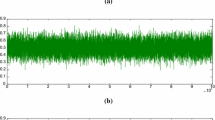Abstract
The replicator equation for a two-person symmetric game, which has an interval of the real line as strategy space, is extended with a mutation term. Assuming that the distribution of the strategies has a continuous density, a partial differential equation for this density is derived. The equation is analysed for two examples. A connection is made with the canonical equation from adaptive dynamics and the continuous stable strategy criterion.






Similar content being viewed by others
References
Arfken GB, Weber HJ (2012) Mathematical methods for physicists, 7th edn. Academic Press, Oxford
Bürger R, Bomze IM (1996) Stationary distributions under mutation-selection balance: structure and properties. Adv Appl Prob 28:227–251
Champagnat N, Ferrière R, Méléard S (2006) Unifying evolutionary dynamics: from individual stochastic processes to macroscopic models. Theor Popul Biol 69:297–321
Cressman R, Hofbauer J (2005) Measure dynamics on a one-dimensional continuous trait space: theoretical foundations for adaptive dynamics. Theor Popul Biol 67:47–59
Cressman R, Hofbauer J, Riedel F (2006) Stability of the replicator equation for a single-species with a multi-dimensional trait space. J Theor Biol 239:273–288
Dieckmann U, Law R (1996) The dynamical theory of coevolution: a derivation from stochastic ecological processes. J Math Biol 34:579–612
Diekmann O (2004) A beginner’s guide to adaptive dynamics. In: Rudnicki R (ed) Mathematical modelling of population dynamics, vol 63. Banach Center Publications, Institute of Mathematics, Polish Academy of Sciences, Poland, pp 47–86
Friedman D, Ostrov DN (2013) Evolutionary dynamics over continuous action spaces for population games that arise from symmetric two-player games. J Econ Theory 148(2):743–777
van Kampen NG (2007) Stochastic processes in physics and chemistry, 3rd edn. Elsevier, Amsterdam
Kimura M (1965) A stochastic model concerning the maintenance of genetic variability in quantitative characters. Proc Natl Acad Sci USA 54:731–736
Oechssler J, Riedel F (2001) Evolutionary dynamics on infinite strategy spaces. Econ Theory 17:141–162
Oechssler J, Riedel F (2002) On the dynamic foundation of evolutionary stability in continuous models. J Econ Theory 107:223–252
Ohtsuki H (2011) Evolutionary dynamics of the Nash demand game: a diffusion approach. Dyn Games App 1(3):449–461
Pao CV (1992) Nonlinear parabolic and elliptic equations. Plenum Press, New York
Ruijgrok M, Ruijgrok Th W (2005) Replicator dynamics with mutations for games with a continuous strategy set, arXiv:nlin/0505032
Wei J, Norman E (1964) On the global representations of the solutions of linear differential equations as a product of exponentials. Proc Am Math Soc 15:327–334
Author information
Authors and Affiliations
Corresponding author
Appendix
Appendix
We have
Introducing the variable \(y=\xi -g_X+g_Y\), we can expand \(e^{-2n\tau } H_n(\xi +g_Y)=e^{-2n\tau } H_n(y+g_X)\), using \(H_n(z)=h_{n,n}z^n+h_{n,n-1}z^{n-1}+\ldots +h_{n,0}\):
with \(|r_1(\tau )| \le C_1\), for some \(C_1>0\) and all \(\tau >0\). Here we have used that there exists an \(M>0\), such that \(e^{-2\tau }|g_X|\ge M\), for all \(\tau >0\).
The \(L^1\) norm of \(e^{-y^2/2} R_n(y,\tau )\) can be estimated as
where \(|r_2(\tau )| \le C_2\), for some \(C_2>0\) and all \(\tau >0\).
Combining (48) and (49), we find
Here, with some abuse of notation, \(\tilde{R_n}(y,\tau )\) has absorbed in each step all bounded terms, so that we have \(||\tilde{R_n}(y,\tau )||_1<M_n\), for some \(M_n>0\) and all \(\tau >0\). Moreover, since \(\tilde{R_n}(y,\tau )\) is a polynomial in \(y\) whose time-dependent coefficients are either exponential functions in \(\tau \), or are bounded from below by such functions, we have that \(||\frac{\partial }{\partial \tau }\tilde{R_n}(y,\tau )||_1\) is also bounded. We will assume, without proof, that there exists an \(M>0\) such that \(M_n\le M\) for all \(n\), so that there exists a function \(R(y,\tau )\) with \(||\tilde{R_n}(y,\tau )||_1\le ||R(y,\tau )||_1\le M\), such that
We then have
Since \(\hat{\rho }(\xi ,\tau )>0\), we must have that \(\sum _{n=0}^{\infty }a_{n}c_n h_{n,n}(e^{-2\tau }g_X)^{n}>0\), for \(\tau \) sufficiently large. The normalization term factor, for large \(\tau \), now becomes
with \(|r_3(\tau )|\le C_3\), for some \(C_3>0\) and all \(\tau >0\).
This then yields, as \(\tau \) grows large,
with \(R(\xi ,\tau )\) uniformly bounded in the \(L^1\) norm (and again with some abuse of notation with regards to \(R(\xi ,\tau )\).)
It follows from the construction that \(\int _S \xi R(\xi ,\tau )\, \mathrm{d}\xi \) is bounded, so
where both \(r(\tau )\) and \(r'(\tau )\) are uniformly bounded.
Rights and permissions
About this article
Cite this article
Ruijgrok, M., Ruijgrok, T.W. An Effective Replicator Equation for Games with a Continuous Strategy Set. Dyn Games Appl 5, 157–179 (2015). https://doi.org/10.1007/s13235-014-0118-y
Published:
Issue Date:
DOI: https://doi.org/10.1007/s13235-014-0118-y




